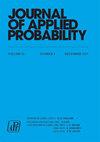停止未知状态的问题
IF 0.7
4区 数学
Q3 STATISTICS & PROBABILITY
引用次数: 0
摘要
我们将全信息下最优停止问题的经典设置扩展到包含未知状态的问题。该框架允许未知状态影响(i)底层过程的漂移,(ii)回报函数,以及(iii)时间范围的分布。由于假设停止器观察底层过程和随机视界,因此这是一个双源学习问题。为未知状态指定先验分布,可以使用标准滤波理论将问题嵌入马尔可夫框架中,其中一个额外的状态变量表示未知状态的后验。我们提供了这个马尔可夫问题的一个方便的公式,基于一种将底层过程与新状态变量解耦的度量变化技术。此外,我们通过几个新的例子表明,这种简化公式可以明确地用于解决问题。本文章由计算机程序翻译,如有差异,请以英文原文为准。
Stopping problems with an unknown state
We extend the classical setting of an optimal stopping problem under full information to include problems with an unknown state. The framework allows the unknown state to influence (i) the drift of the underlying process, (ii) the payoff functions, and (iii) the distribution of the time horizon. Since the stopper is assumed to observe the underlying process and the random horizon, this is a two-source learning problem. Assigning a prior distribution for the unknown state, standard filtering theory can be employed to embed the problem in a Markovian framework with one additional state variable representing the posterior of the unknown state. We provide a convenient formulation of this Markovian problem, based on a measure change technique that decouples the underlying process from the new state variable. Moreover, we show by means of several novel examples that this reduced formulation can be used to solve problems explicitly.
求助全文
通过发布文献求助,成功后即可免费获取论文全文。
去求助
来源期刊

Journal of Applied Probability
数学-统计学与概率论
CiteScore
1.50
自引率
10.00%
发文量
92
审稿时长
6-12 weeks
期刊介绍:
Journal of Applied Probability is the oldest journal devoted to the publication of research in the field of applied probability. It is an international journal published by the Applied Probability Trust, and it serves as a companion publication to the Advances in Applied Probability. Its wide audience includes leading researchers across the entire spectrum of applied probability, including biosciences applications, operations research, telecommunications, computer science, engineering, epidemiology, financial mathematics, the physical and social sciences, and any field where stochastic modeling is used.
A submission to Applied Probability represents a submission that may, at the Editor-in-Chief’s discretion, appear in either the Journal of Applied Probability or the Advances in Applied Probability. Typically, shorter papers appear in the Journal, with longer contributions appearing in the Advances.
 求助内容:
求助内容: 应助结果提醒方式:
应助结果提醒方式:


